overheating CHEVROLET ASTRO 1998 2.G Owners Manual
[x] Cancel search | Manufacturer: CHEVROLET, Model Year: 1998, Model line: ASTRO, Model: CHEVROLET ASTRO 1998 2.GPages: 414, PDF Size: 21.46 MB
Page 145 of 414

Downloaded from www.Manualslib.com manuals search engine Anti-Lock Brake System Warning Light
ANTI -
LOCK
With the anti-lock brake
system, this light will come
on when
you start your
engine and may stay
on for
several seconds.
That’s normal.
If the light stays on, or comes on when you’re driving,
your vehicle needs service.
If the regular brake system
warning light isn’t on,
you still have brakes, but you
don’t have anti-lock brakes.
If the regular brake system
warning light is also on, you don’t have anti-lock brakes
and there’s a problem with your regular brakes. See
“Brake System Warning Light’’ earlier in this section.
The anti-lock brake system warning light should come
on briefly when you turn the ignition key to RUN. If the
light doesn’t come on then, have
it fixed so it will be
ready to warn
you if there is a problem.
Engine Coolant Temperature Gage
If the gage pointer moves to
the red area, your engine
is
too hot!
It means that your engine coolant has overheated. If you
have been operating your vehicle under normal driving
conditions,
you should pull off the road, stop your
vehicle and turn off the engine as soon as possible.
The “Problems on the Road” section of this manual
shows
you what to do. See “Engine Overheating” in
the Index.
2-61
Page 219 of 414

Downloaded from www.Manualslib.com manuals search engine Making Turns
NOTICE:
Making very sharp turns while trailering could cause the trailer
to come in contact with the
vehicle.
Your vehicle could be damaged. Avoid
making very sharp turns while trailering.
When you’re turning with a trailer, make wider turns than
normal. Do this so your trailer won’t strike soft shoulders,
curbs, road signs, trees or other objects. Avoid jerky or
sudden maneuvers. Signal well
in advance.
Turn Signals When Towing a Trailer
When you tow a trailer, your vehicle has to have extra
wiring (included in the optional trailering package).
The arrows on your instrument panel will flash
whenever you signal a turn or lane change. Properly
hooked
up, the trailer lamps
drivers you’re about to turn, will
also flash, telling other
change lanes or stop. When
towing a trailer, the arrows on your instrument
panel will flash
for turns even if the bulbs on the trailer
are burned out. Thus, you may think drivers behind you
are seeing your signal when they are not. It’s important
to check occasionally to be sure the trailer bulbs are
still working.
Driving On Grades
Reduce speed and shift to a lower gear before you start
down a long or steep downgrade. If you don’t shift
down, you might have to use your brakes
so much that
they would get hot and no longer work well.
On a long uphill grade, shift down and reduce your
speed
to around 45 mph (70 kdh) to reduce the
possibility of engine and transmission overheating.
When towing
at high altitude on steep uphill grades,
consider the following: Engine coolant will boil at a
lower temperature than at normal altitudes. If you turn
your engine off immediately after towing at high altitude
on steep uphill grades, your vehicle may show signs
similar to engine overheating.
To avoid this, let the
engine
run while parked (preferably on level ground)
with the automatic transmission in
PARK (P) for a few
minutes before turning the engine off. If you do get the
overheat warning, see “Engine Overheating” in
the Index.
4-35
Page 223 of 414
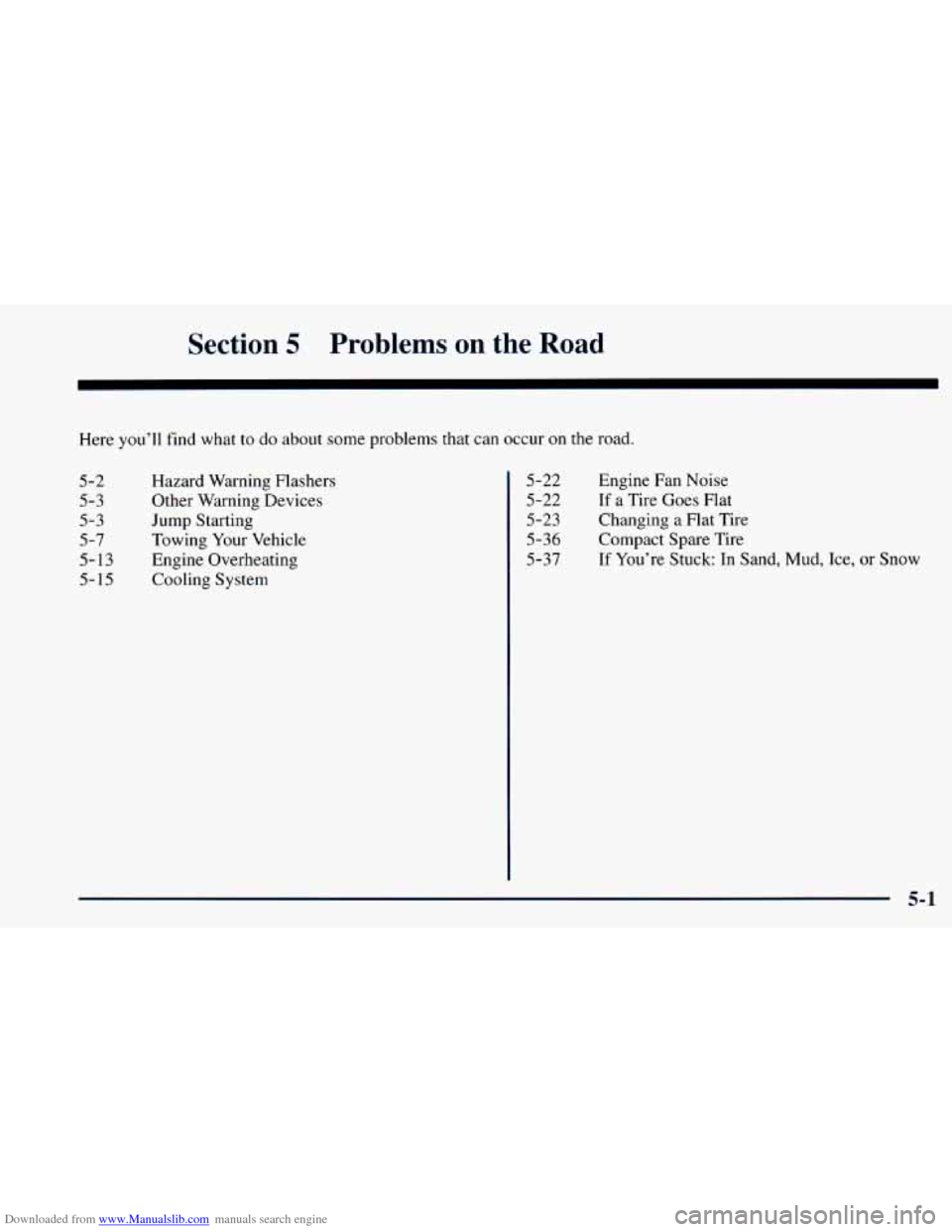
Downloaded from www.Manualslib.com manuals search engine Section 5 Problems on the Road
Here you’ll find what to do about some problems that can occur on the road.
5-2
5-3 5-3
5-7
5-13
5- 15 Hazard
Warning Flashers
Other Warning Devices
Jump Starting
Towing Your Vehicle
Engine Overheating
Cooling System 5-22
5-22
5-23
5-36 5-37 Engine
Fan Noise
If a Tire Goes Flat
Changing a Flat Tire
Compact Spare Tire
If You’re Stuck: In Sand, Mud, Ice, or Snow
5-1
Page 235 of 414
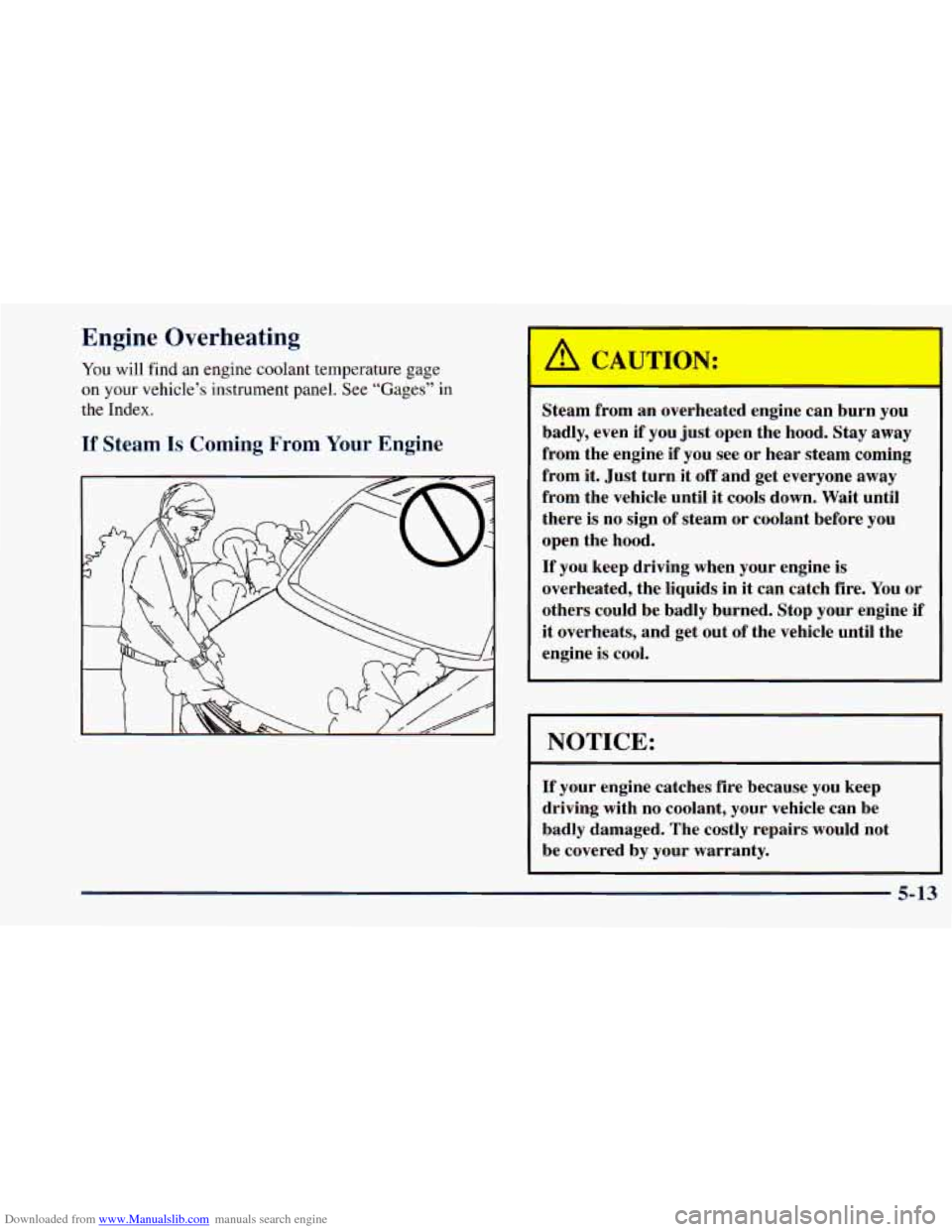
Downloaded from www.Manualslib.com manuals search engine Engine Overheating
You will find an engine coolant temperature gage
on your vehicle’s instrument panel. See “Gages” in
the Index.
If Steam Is Coming From Your Engine
A CAUTION:
Steam from an overheated engine can burn you
badly, even if you just open the hood. Stay
away
from the engine if you see or hear steam coming
from it. Just turn it
off and get everyone away
from the vehicle until it cools down. Wait until
there is no sign of steam or coolant before you
open the hood.
If you keep driving when your engine is
overheated, the liquids in it can catch fire. You or
others could be badly burned. Stop your engine if
it overheats, and get out of the vehicle until the
engine is cool.
NOTICE:
If your engine catches fire because you keep
driving with no coolant, your vehicle can be
badly damaged. The costly repairs would not
be covered by your warranty.
5-13
Page 287 of 414
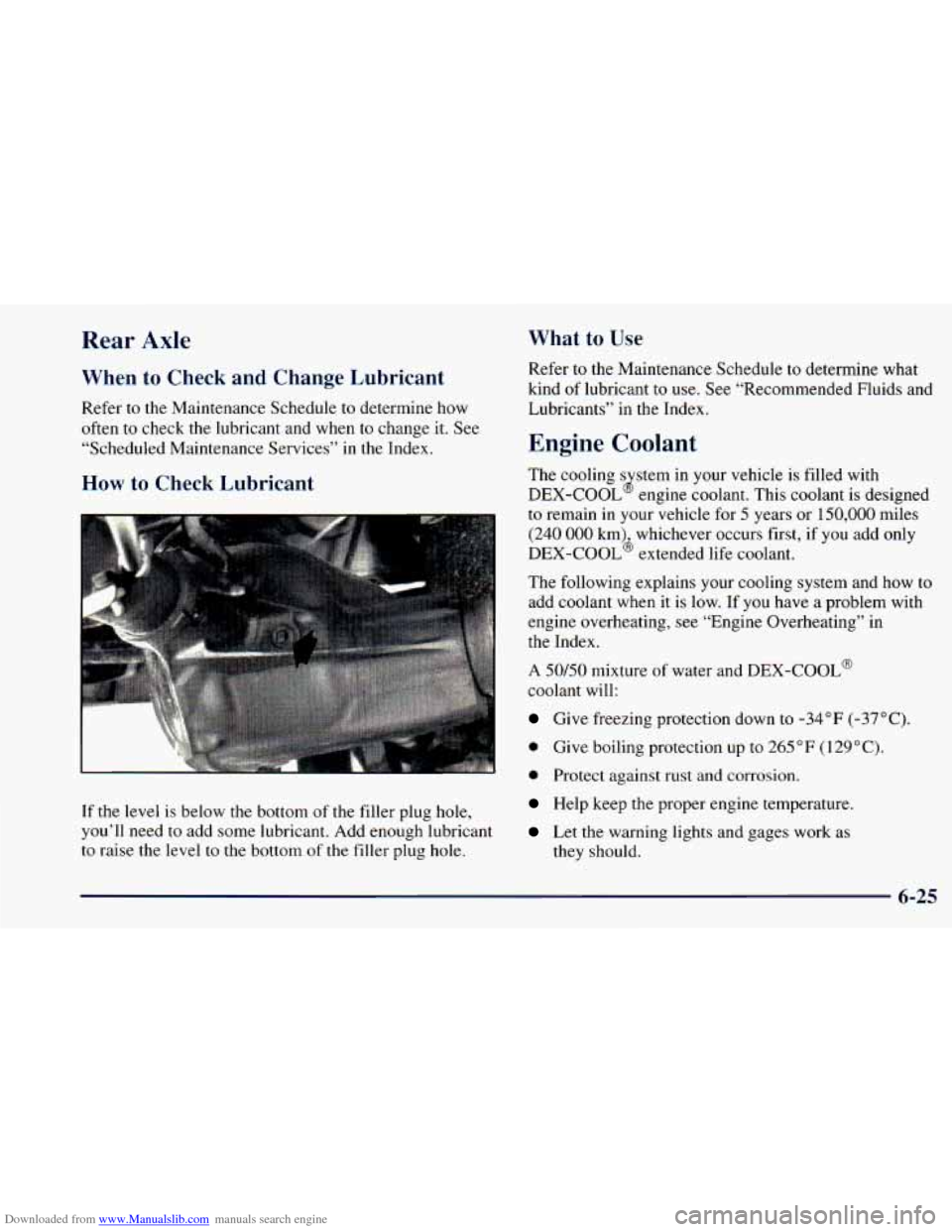
Downloaded from www.Manualslib.com manuals search engine Rear Axle
When to Check and Change Lubricant
Refer to the Maintenance Schedule to determine how
often
to check the lubricant and when to change it. See
“Scheduled Maintenance Services” in the Index.
How to Check Lubricant
If the level is below the bottom of the filler plug hole,
you’ll need to add some lubricant. Add enough lubricant
to raise the level to the bottom
of the filler plug hole.
What to Use
Refer to the Maintenance Schedule to determine what
kind of lubricant
to use. See “Recommended Fluids and
Lubricants” in the Index.
Engine Coolant
The cooling s stem in your vehicle is filled with
DEX-COOL engine coolant. This coolant
is designed
to remain in your vehicle for
5 years or 150,000 miles
(240
000 km) whichever occurs first, if you add only
DEX-COOL’ extended life coolant.
The following explains your cooling system and how to
add coolant when it is low. If you have a problem with
engine overheating,
see “Engine Overheating” in
the Index.
A 50/50 mixture of water and DEX-COOL@
coolant will:
Give freezing protection down to -34°F (-37°C).
0 Give boiling protection up to 265 “F ( 129°C).
0 Protect against rust and corrosion.
Help keep the proper engine temperature.
Let the warning lights and gages work as
B
they should.
6-25
Page 290 of 414
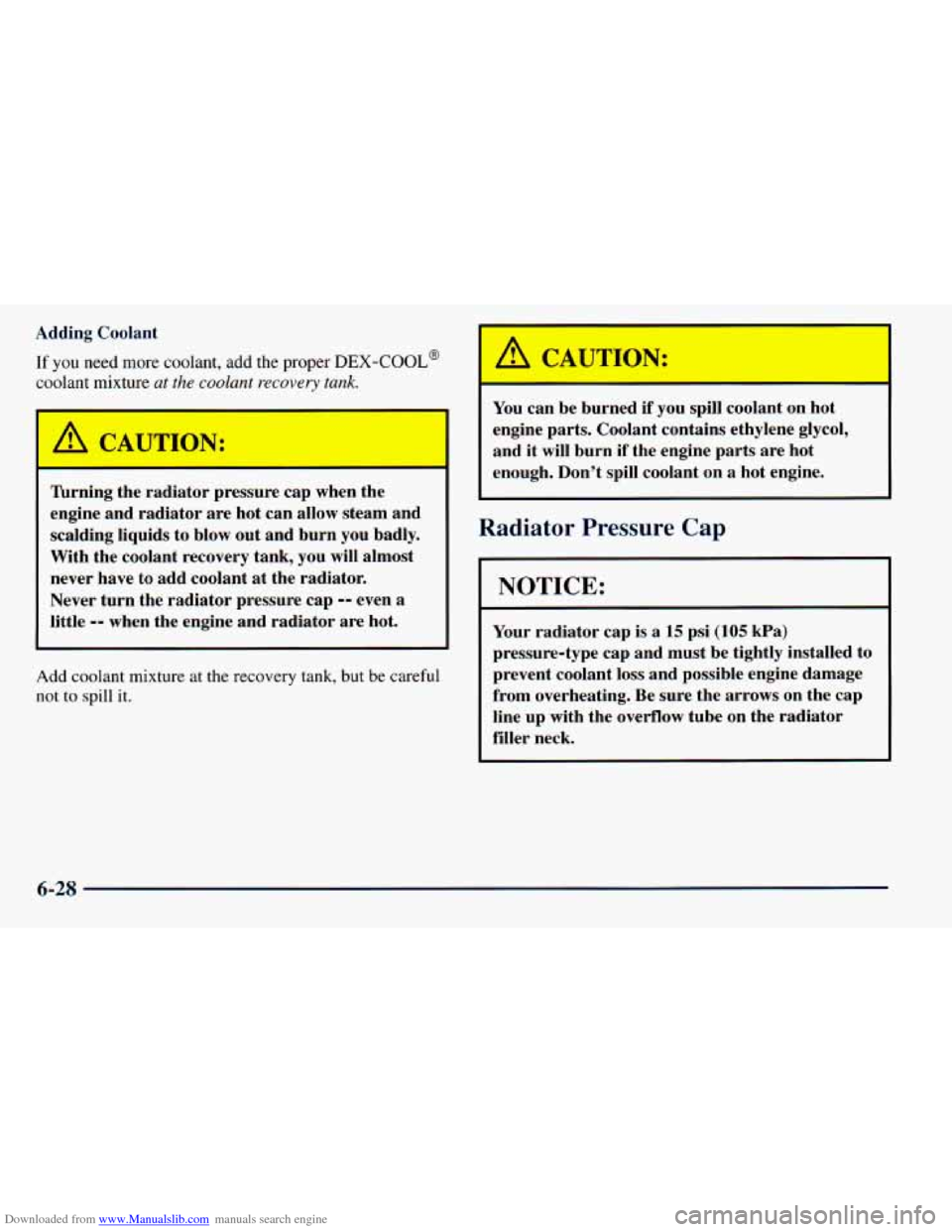
Downloaded from www.Manualslib.com manuals search engine Adding Coolant
If you need more coolant, add the proper DEX-COOL@
coolant mixture at the coolant recovery tank.
A CAUTION:
lhrning the radiator pressure cap when the
engine and radiator are hot can allow steam and
scalding liquids to blow out and burn you badly.
With the coolant recovery tank, you
will almost
never have
to add coolant at the radiator.
Never turn the radiator pressure cap
-- even a
little
-- when the engine and radiator are hot.
Add coolant mixture at the recovery tank, but be careful
not to spill it.
A CAUTION:
You can be burned if you spill coolant on hot
engine parts. Coolant contains ethylene glycol,
and it will burn if the engine parts are hot
enough. Don’t spill coolant on a hot engine.
Radiator Pressure Cap
NOTICE:
Your radiator cap is a 15 psi (105 kPa)
pressure-type cap and must be tightly installed to
prevent coolant loss and possible engine damage
from overheating. Be sure the arrows on the cap
line up with the overflow tube on the radiator
filler neck.
6-28
Page 305 of 414
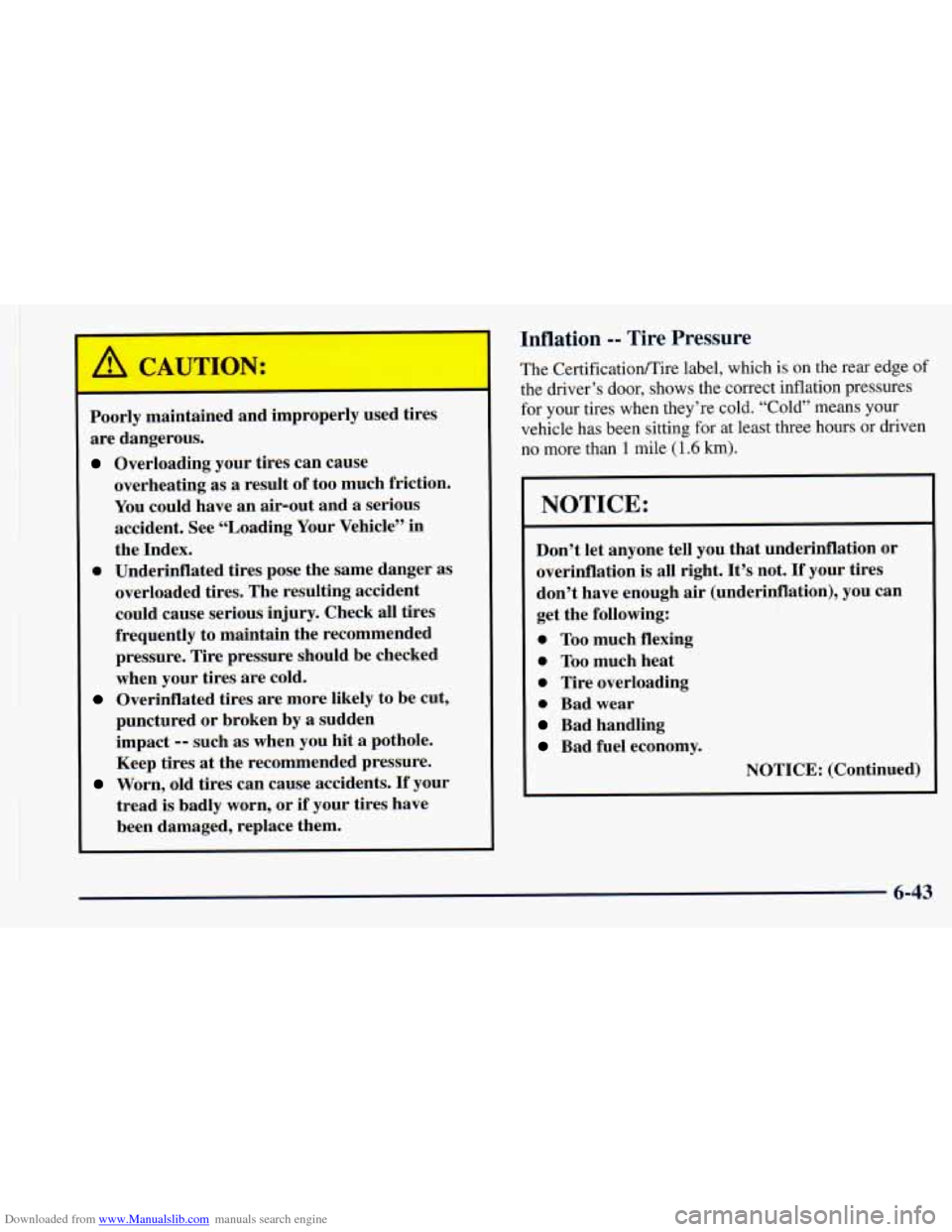
Downloaded from www.Manualslib.com manuals search engine A CAUTION:
Poorly maintained and improperly used tires
are dangerous.
Overloading your tires can cause
overheating as a result of too much friction.
You could have an air-out and a serious
accident. See “Loading Your Vehicle” in
the Index.
0 Underinflated tires pose the same danger as
overloaded tires. The resulting accident
could cause serious injury. Check all tires
frequently to maintain the recommended pressure. Tire pressure should be checked
when your tires are cold.
Overinflated tires are more likely to be cut,
punctured or broken by a sudden
impact
-- such as when you hit a pothole.
Keep tires
at the recommended pressure.
Worn, old tires can cause accidents. If your
tread
is badly worn, or if your tires have
been damaged, replace them.
Inflation -- Tire Pressure
The CertificatiodTire label, which is on the rear edge of
the driver’s door, shows the correct inflation pressures
for your tires when they’re cold. “Cold” means your
vehicle has been sitting for at least three hours or driven
no more than
1 mile (1.6 km).
NOTICE:
I
Don’t let anyone tell you that underinflation or
overinflation is all right. It’s not.
If your tires
don’t have enough air (underinflation), you can
get the following:
0 Too much flexing
0 Too much heat
0 Tire overloading
0 Bad wear
Bad handling
Bad fuel economy.
I
NOTICE: (Continued)
6-43
Page 401 of 414

Downloaded from www.Manualslib.com manuals search engine Cooling System .................. ... 5-15
Customer Assistance for Text Telephone Users ......... 8-4
Courtesy Transportation
......................... 8-8
Cruise Control
................................. 2-34
Customer Assistance Information
................... 8- I
Customer Satisfaction Procedure .................... 8-2
Damage. Finish
............................... 6-57
Damage. Sheet Metal ............................ 6-57
Daytime Running Lamps
......................... 2-38
Daytime Running Lamps Indicator Light
............ 2-66
Dead Battery
................................... 5-3
Defects. Reporting Safety
................... 8- IO. 8- 1 1
Defensive Driving ............................... 4-2
Defogger. Rear Window
.......................... 3-8
Defrosting
..................................... 3-6
Dimensions. Vehicle
............................ 6-69
Dome Lamps
.............................. 2-39
Door Front
.......... ........................ 2-4
Rear
........................................ 2-4
Sliding
..................................... 2-10
Drive Position ................................. 2-21
Driver Position
................................. 1 - I 8
Driving
City
........................................ 4-17
Defensive
.................................... 4-2
Drunken
..................................... 4-2
Freeway
.................................... 4-18
InaBlizzard
................................. 4-24
In Foreign Countries
........................... 6-5
IntheRain .................................. 4-15
Locks
....................................... 2-6 Night
...................................... 4-13
OnCurves
................................... 4-9
On Grades While Towing a Trailer
............... 4-35
On
Hill and Mountain Roads .................... 4-21
OnSnowandIce ............................. 4-23
Through Water
............................... 4-17
WetRoads
.................................. 4-15
Winter
...................................... 4-22
With
a Trailer ................................ 4-33
Drunken Driving
................................ 4-2
Electrical Equipment. Adding
.......... 2-18. 3-28. 6-60
Electrical System
............................... 6-60
Engine
........................................ 6-9
Coolant
..................................... 6-25
Coolant Heater
............................... 2-18
Coolant Level Check
.......................... 7-41
Cooling System Capacity
....................... 6-67
Cover
...................................... 6-15
Exhaust
................. 2-13.2-27.2.30.4.25. 4.33
FuseBlock
.................................. 6-64
Identification
................................ 6-59
OilLevelCheck
.............................. 7-41
Overheating
................................. 5-13
Running While Parked
......................... 2-27
Specifications
................................ 6-67
Starting
..................................... 2-17
Temperature Gage
............................ 2-61
Engineoil
.................................... 6-10
Adding ..................................... 6-12
Additives
................................... 6-14
Checking
................................... 6-11
Pressure Gage
................................ 2-64
9-3
Page 404 of 414

Downloaded from www.Manualslib.com manuals search engine Locks (Continued) Key Lock Cylinder Service
..................... 7-42
PowerDoor
.................................. 2-6
Sliding Door Child Security
..................... 2- 1 1
Lubricants and Fluids ............................ 7-47
Lubrication Service. Body
........................ 7-42
Luggagecarrier
................................ 2-47
Lumbar Controls
............................ 1-3
Maintenance. Normal Replacement Parts
........... 6-69
Maintenance Record
............................ 7-49
Maintenance Schedule
............................ 7- I
Long Trip/Highway ........................... 7-29
Long Trip/Highway Definition
................... 7-6
Long Trip/Highway Intervals
..................... 7-7
Owner Checks and Services
..................... 7-41
Periodic Maintenance Inspections
................ 7-45
Recommended Fluids and Lubricants
............. 7-47
Scheduled Maintenance Services
.................. 7-4
Short Trip/City
................................ 7-8
Short Trip/City Definition
....................... 7-5
Short Trip/City Intervals ........................ 7-5
Maintenance. Underbody
......................... 6-57
Maintenance When Trailer Towing
................. 4-36
Malfunction Indicator Lamp
...................... 2-62
ManualFrontSeat
............................... 1-2
Manual Lumbar Support
.......................... 1-3
Methanol ...................................... 6-4
Mirrors
....................................... 2-40
Convex Outside
.............................. 2-41
Inside Day/Night Rearview
..................... 2-40
Outside
..................................... 2-40
Visor Vanity
................................. 2-49 MMT
......................................... 6-4
Model Reference
................................. vi
Mountain Roads
................................ 4-21
Net. Convenience
.............. ........ 2-47
Neutral
....................................... 2-20
New Vehicle Break-In
........................... 2-15
Nightvision
................................... 4-14
Normal Maintenance Replacement Parts
............. 6-69
Odometer
.................................... 2-57
Odometer. Trip
................................. 2-57
Off-Road Recovery
............................. 4-10
Oil. Engine
.................................... 6-10
Opener. Garage Door
............................ 2-44
Outside Mirror
................................. 2-40
Overhead Console
.............................. 2-43
Overheating Engine
............................. 5-13
Owner Checks and Services
....................... 7-41
Owner Publications. Ordering
.............. 8- 11. 8- 12
Paint Spotting. Chemical ........................ 6-57
Park
......................................... 2-19
Shifting Into
................................. 2-23
Shifting Out of
............................... 2-26
Parking AtNight
.................................... 2-14
Brake
...................................... 2-22
Brake Mechanism Check
....................... 7-44
Lots
....................................... 2-14
With
a Trailer ................................ 4-36
Over
Things That
Burn ........................ 2-26
9-6